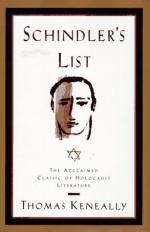|
This section contains 3,880 words (approx. 13 pages at 300 words per page) |

|
SOURCE: White, Armond. “Toward a Theory of Spielberg History.” Film Comment 30, no. 2 (March 1994): 51-8.
In the following review, White addresses Schindler's List as a work of historical realism and considers the film to be Spielberg's “most compromised” work.
1.
“Witnessing,” a term repeated in the most doctrinaire reviews of Schindler's List, actually happens only once in the movie. Steven Spielberg “witnesses” the tribute he has arranged in which survivors of the WWII Holocaust file past the gravesite of Oskar Schindler. It is a perfectly situated affirmation of the gratitude and humanity that a group of people express toward a man who saved their lives. The profound optimism—the goodness—of human experience has always been the subject of Spielberg's greatest art: Close Encounters of the Third Kind ('77), The Color Purple ('85), E.T. ('82)—each an ebullient fantasy. But there's no awareness of this sensibility in the widespread...
|
This section contains 3,880 words (approx. 13 pages at 300 words per page) |

|


